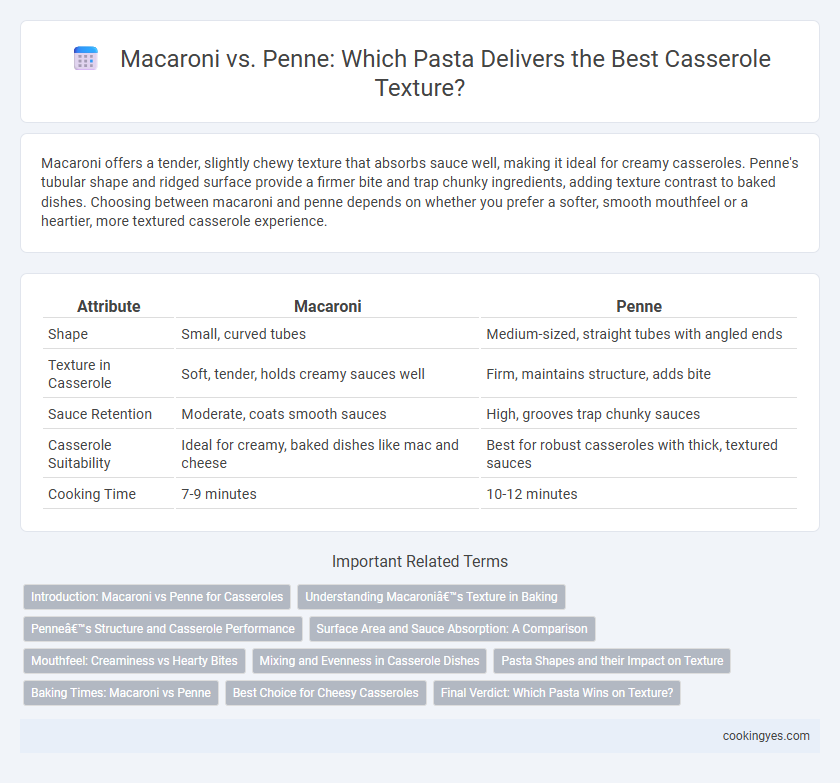Macaroni offers a tender, slightly chewy texture that absorbs sauce well, making it ideal for creamy casseroles. Penne's tubular shape and ridged surface provide a firmer bite and trap chunky ingredients, adding texture contrast to baked dishes. Choosing between macaroni and penne depends on whether you prefer a softer, smooth mouthfeel or a heartier, more textured casserole experience.
Table of Comparison
| Attribute | Macaroni | Penne |
|---|---|---|
| Shape | Small, curved tubes | Medium-sized, straight tubes with angled ends |
| Texture in Casserole | Soft, tender, holds creamy sauces well | Firm, maintains structure, adds bite |
| Sauce Retention | Moderate, coats smooth sauces | High, grooves trap chunky sauces |
| Casserole Suitability | Ideal for creamy, baked dishes like mac and cheese | Best for robust casseroles with thick, textured sauces |
| Cooking Time | 7-9 minutes | 10-12 minutes |
Introduction: Macaroni vs Penne for Casseroles
Macaroni's small, curved tubes create a tender, consistent texture in casseroles by trapping cheese and sauce evenly throughout the dish. Penne's ridged, larger tubes offer a firmer bite and hold thicker, chunkier sauces well, contributing to a heartier, more structured casserole texture. Choosing macaroni or penne impacts the casserole's mouthfeel, with macaroni delivering a creamier, melt-in-your-mouth experience and penne providing a robust, chewy contrast.
Understanding Macaroni’s Texture in Baking
Macaroni's hollow, curved shape with a smooth surface absorbs sauce evenly, creating a creamy, cohesive texture in casseroles. Unlike penne, which has ridges and is thicker, macaroni softens quickly, blending seamlessly with cheese and ingredients without overwhelming the dish. This tender consistency enhances the overall mouthfeel, making macaroni ideal for classic baked casseroles.
Penne’s Structure and Casserole Performance
Penne's tubular structure with ridged surfaces enhances sauce absorption and maintains firmness during baking, making it superior to macaroni for casseroles. Unlike macaroni's curved, hollow shape which can become mushy, penne holds its shape better and offers a chewier texture. This makes penne ideal for casseroles requiring distinct pasta bite and well-distributed sauce.
Surface Area and Sauce Absorption: A Comparison
Macaroni's smooth, curved tubes offer less surface area compared to penne's ridged, cylindrical shape, affecting sauce adhesion in casseroles. Penne's ridges trap more sauce, enhancing flavor distribution and contributing to a moister texture. This increased surface area allows penne casseroles to maintain a richer taste, while macaroni tends to produce a lighter, less saucy dish.
Mouthfeel: Creaminess vs Hearty Bites
Macaroni offers a smoother, creamier mouthfeel in casseroles due to its smaller, curved tubes that hold sauces evenly. Penne provides hearty bites with its ridged, larger tubes that retain chunks and offer more textured, substantial chewing. Choosing between macaroni and penne directly impacts the casserole's creaminess versus robust, textured eating experience.
Mixing and Evenness in Casserole Dishes
Macaroni's curved shape and hollow center allow sauces and ingredients to coat and fill each piece evenly, enhancing the casserole's overall texture and mixing. Penne's ridges and larger size can create distinct layers in casseroles, but may result in less uniform blending compared to macaroni's smaller, uniform pieces. For casseroles that prioritize consistent texture and even distribution of flavors, macaroni ensures a well-mixed and cohesive dish.
Pasta Shapes and their Impact on Texture
Macaroni features a small, curved tubular shape that traps creamy sauces effectively, creating a smooth, cohesive casserole texture. Penne's larger, ridged tubes provide a firmer bite and more pronounced sauce retention, resulting in a chunkier, more textured casserole experience. The distinct shapes influence moisture distribution and mouthfeel, making macaroni ideal for silky casseroles while penne suits hearty, robust dishes.
Baking Times: Macaroni vs Penne
Macaroni's smaller, curved tubes typically require shorter baking times than Penne, which is larger and denser, absorbing more sauce and heat. Penne maintains a firmer texture during longer baking, making it ideal for casseroles that benefit from a chewy consistency. Macaroni softens more quickly, resulting in a creamier and more tender casserole outcome.
Best Choice for Cheesy Casseroles
Macaroni's curved, hollow shape allows cheese sauce to cling better, creating a creamy and cohesive texture ideal for cheesy casseroles. Compared to penne, which has a firmer, ridged tube that can hold sauce but may result in a drier bite, macaroni offers a softer, more tender mouthfeel when baked. The small, bendable macaroni pieces evenly distribute cheese, making them the best choice for rich, gooey casserole dishes.
Final Verdict: Which Pasta Wins on Texture?
Macaroni offers a softer, creamier texture that allows casseroles to blend more uniformly, ideal for dishes like classic mac and cheese. Penne provides a firmer bite and ridged surface, which holds sauce well but creates a slightly chewier texture, adding distinct texture contrasts to casseroles. For a smooth, cohesive casserole, macaroni wins on texture, while penne suits casseroles where a more structured, toothsome bite is preferred.
Macaroni vs Penne for casserole texture Infographic

 cookingyes.com
cookingyes.com